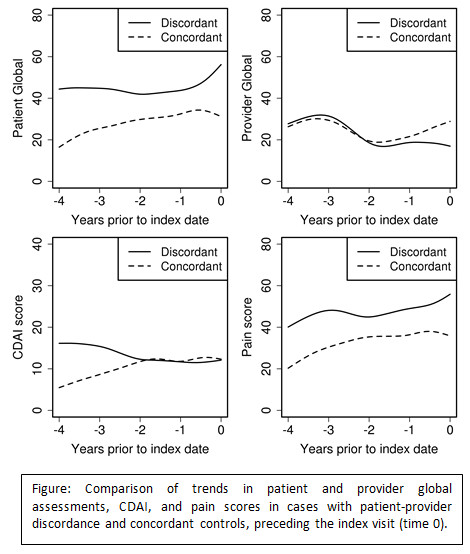Session Information
Date: Sunday, November 13, 2016
Title: Rheumatoid Arthritis – Clinical Aspects - Poster I: Clinical Characteristics/Presentation/Prognosis
Session Type: ACR Poster Session A
Session Time: 9:00AM-11:00AM
Background/Purpose: Patient-provider discordance in global assessment (GA) of disease activity is a potential threat to patient-centered management of individuals with RA. The estimated prevalence of discordance is 33%. A crucial gap remains in the literature regarding the trends and predictors of discordance. Our aim was to determine the persistence over time, predictors and impact of discordance on treatment decisions. Methods: A retrospective case-control study included 102 patients with discordance (defined as patient GA ≥25 mm higher than provider GA) and 102 patients without discordance matched on age, sex, RA disease duration and Clinical Disease Activity Index (CDAI <10 vs. ≥10). Data were collected for the baseline visit (date of diagnosis or earliest available visit); study visit and 11 additional clinical visits prior to the discordant visit. For the baseline visit, duration of symptoms, date of diagnosis, 1st DMARD/biologic used, and use of MTX in the 1st 6 months of diagnosis were recorded. Data for each clinical visit included the patient and provider GAs (0-100 mm), pain visual analog scales (0-100 mm), tender and swollen joint counts (0-28), HAQ, CDAI, radiographic erosions, ESR, CRP, and DMARD/biologic use or modification. Presence of comorbidities, including depression, anxiety, FM, or OA, and use of glucocorticoids, analgesics, antidepressants or anxiolytics, were also abstracted. Data were analyzed using linear and logistic regression models with smoothing splines for non-linear trends. Results: The study included 204 patients with mean age of 60 years, mean RA duration of 7 years, mean CDAI score of 15.4. Analysis of the 3-year trends in the patient and provider GA demonstrated persistence and/or progression of discordance over time (see Figure). Cases had a greater percentage (mean 71% vs. 30%; p<0.001) and higher rate of discordant visits (1.6 vs. 0.6 per year; p<0.001) compared to controls. Baseline predictors of future discordance were (odds ratios [OR] are for a 10-unit change for each characteristic) age (OR=0.14, p=0.04), patient GA (OR=1.44, p<0.001), pain score (OR=1.28, p<0.001), and CDAI score (OR=1.70 per 12 unit increase, p=0.047). Depression (OR=2.00, p=0.04), ever use of antidepressants (OR=3.11, p=0.01) or FM pain medications (OR=2.90, p=0.04) also predicted future discordance. No differences were observed in the cumulative numbers of additions or modifications of the DMARD regimen or in treatment with conventional or biologic DMARDs between cases and controls (all p>0.05). Conclusion: Patient-provider discordance tends to persist and/or progress over time and is associated with consistently higher pain. Early abrogation of inflammatory disease activity through treat-to-target strategies as well as early detection and treatment of comorbid depression and FM could lessen the development of patient-provider discordance.
To cite this abstract in AMA style:
Challa DNV, Kvrgic Z, Crowson CS, Schaffer D, Mason TG II, Persellin ST, Michet C Jr., Wampler Muskardin TL, Wright K, Matteson EL, Davis JM III. Patient-Provider Discordance in Global Assessments of Disease Activity in Patients with Rheumatoid Arthritis: Persistence, Predictors and Impact [abstract]. Arthritis Rheumatol. 2016; 68 (suppl 10). https://acrabstracts.org/abstract/patient-provider-discordance-in-global-assessments-of-disease-activity-in-patients-with-rheumatoid-arthritis-persistence-predictors-and-impact/. Accessed .« Back to 2016 ACR/ARHP Annual Meeting
ACR Meeting Abstracts - https://acrabstracts.org/abstract/patient-provider-discordance-in-global-assessments-of-disease-activity-in-patients-with-rheumatoid-arthritis-persistence-predictors-and-impact/

